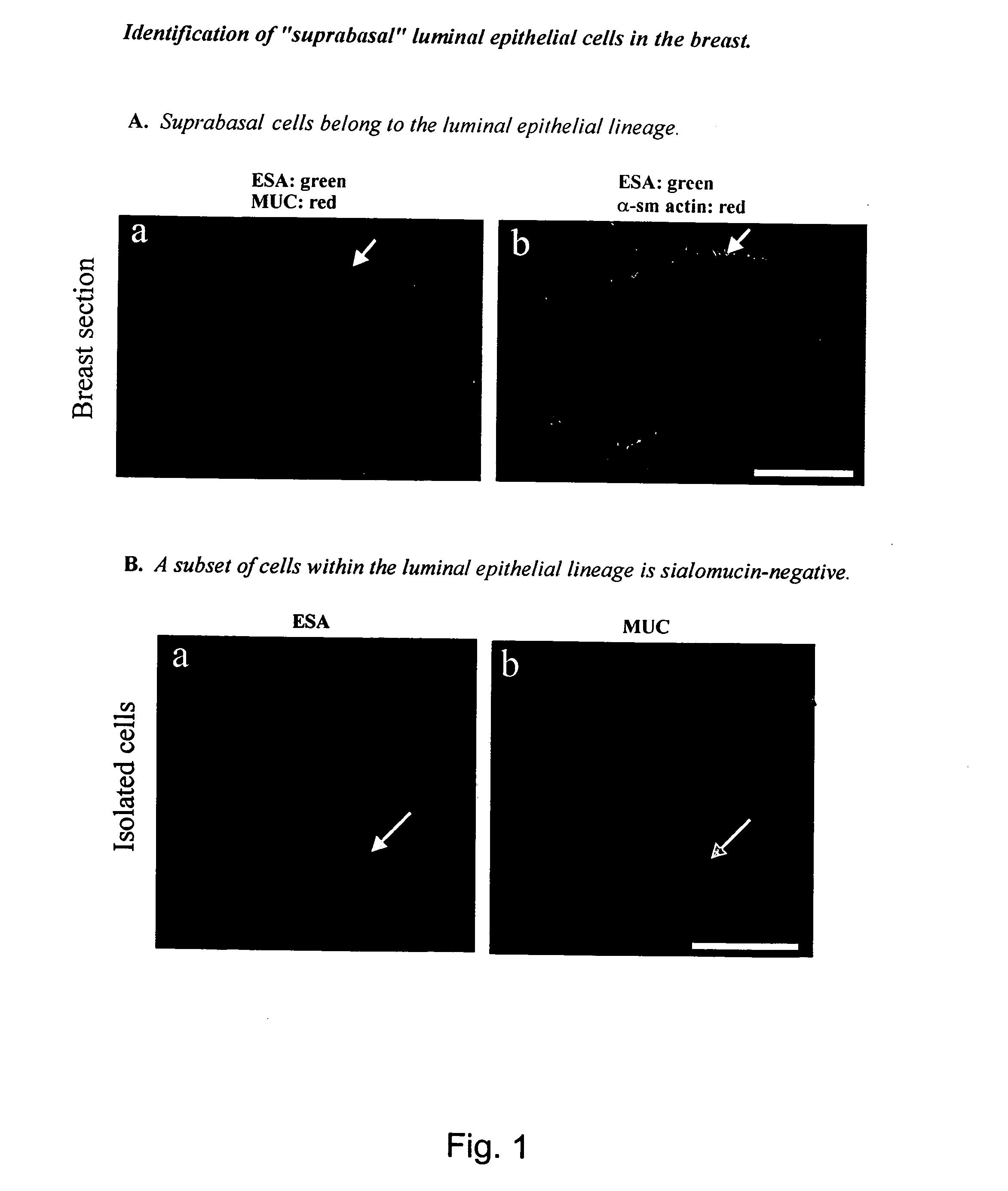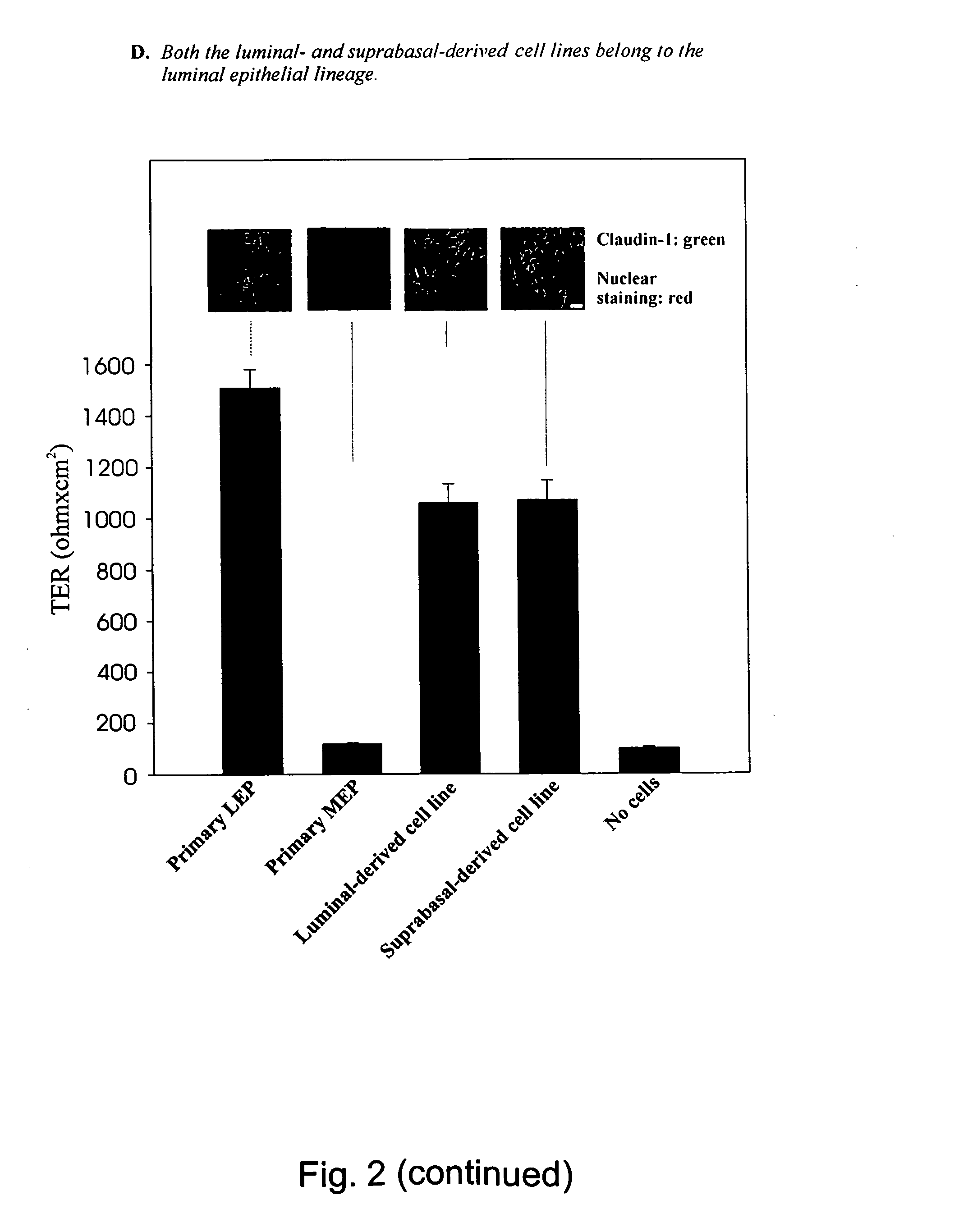Suprabasal breast cell with stem cell properties
a breast cell and stem cell technology, applied in the field of breast cell with stem cell properties, can solve the problems of not being able to characterise the putative stem cell to show the full potential of generating tdlu, and achieve the effect of generating tdlu and demonstrating the full potential of tdlu
- Summary
- Abstract
- Description
- Claims
- Application Information
AI Technical Summary
Benefits of technology
Problems solved by technology
Method used
Image
Examples
example 1
Identification of “Suprabasal” Luminal Epithelial Cells in the Breast
[0105] In culture, a putative “stem” cell of the human breast was defined based on a positive staining for the luminal epithelial marker ESA and a negative or weakly positive staining for sialomucin (MUC) (Stingl et al. 1998). To investigate if such a candidate stem cell could be identified in human breast in vivo, the present inventors double-stained histological sections of normal human breast tissue with epithelial-specific antigen (ESA) and sialomucin (MUC).
[0106] In general, immunocytochemistry and confocal microscopy was performed as follows. Normal human breast tissue was obtained as biopsies from patients undergoing reduction mammoplasty for cosmetic reasons. The use of human material has been reviewed by the Regional Scientific-Ethical Committees for Copenhagen and Frederiksberg, Denmark and approved with reference to (KF) 01-161 / 98. The tissue was frozen in n-hexan (Merck, Darmstadt, Germany) and mount...
example 2
Isolation, Immortalization and Characterization of Luminal and Suprabasal-Derived Epithelial Cells.
[0110] In order to show that the cells described in example 1 indeed have stem cell properties, the cells were isolated by immunomagnetic sorting and characterized.
[0111] Briefly, the luminal epithelial cells were purified from two consecutive sialomucin-columns and the suprabasal epithelial cells were purified as the flow-through from a sialomucin-column which was later retained in an ESA-column. To generate cell lines, the present inventors immortalised both populations with an E6 / E7 construct of HPV16. The resulting established cell lines are referred to below as the luminal and suprabasal-derived epithelial cells, respectively.
Cell Culture
[0112] Breast luminal epithelial cells were generated from primary cultures of biopsies from patients undergoing reduction mammoplasty for cosmetic reasons. The tissue was prepared as previously described (Péchoux et al. 1999). Briefly, it w...
example 3
Clonal Cell Lines of the Suprabasal-Derived Epithelial Cell Line are Multipotent
[0128] Clonal cultures were established and double-stained for keratin K18 (luminal marker) and K14 (myoepithelial marker) as described in example 1 by using antibodies against keratin K18 (F3006; Trichem Aps, Denmark) and keratin K14 (LL002, NovoCastra, Newcastle upon Tyne, UK) as primary antibodies, se also Table 4.
[0129] Whereas the luminal-derived epithelial cell line did not generate any myoepithelial cells and stained for K18 only, the suprabasal-derived cell line readily formed mixed clones of luminal epithelial and myoepithelial cells (FIG. 3A). The present inventors found that these myoepithelial cells represented a primitive level of myoepithelial differentiation because + cells were also precursor cells of a lineage-restricted progeny within the luminal compartment, they could further mature within this compartment to differentiated cells. Sialomucin-expressing cells were eliminated by rete...
PUM
| Property | Measurement | Unit |
|---|---|---|
| pore size | aaaaa | aaaaa |
| volume | aaaaa | aaaaa |
| volume | aaaaa | aaaaa |
Abstract
Description
Claims
Application Information
 Login to View More
Login to View More - R&D
- Intellectual Property
- Life Sciences
- Materials
- Tech Scout
- Unparalleled Data Quality
- Higher Quality Content
- 60% Fewer Hallucinations
Browse by: Latest US Patents, China's latest patents, Technical Efficacy Thesaurus, Application Domain, Technology Topic, Popular Technical Reports.
© 2025 PatSnap. All rights reserved.Legal|Privacy policy|Modern Slavery Act Transparency Statement|Sitemap|About US| Contact US: help@patsnap.com



